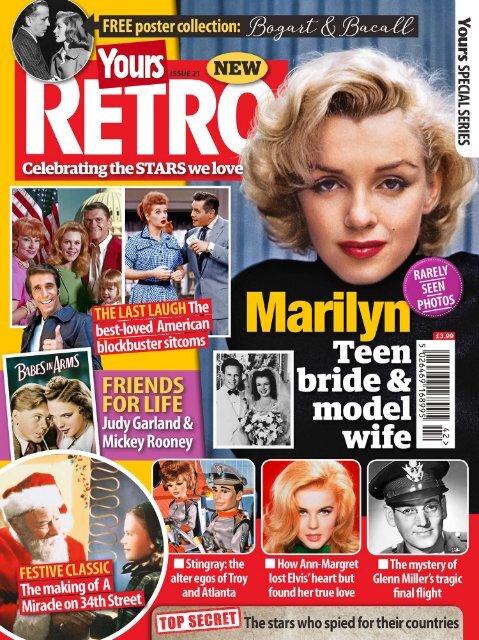You also want an ePaper? Increase the reach of your titles
YUMPU automatically turns print PDFs into web optimized ePapers that Google loves.
RETRO First love<br />
Michelle Morgan investigates how<br />
Norma Jeane came to marry the boy<br />
next door and why her burgeoning<br />
career as Marilyn Monroe spelled the<br />
end of their marriage<br />
Marilyn<br />
…becoming<br />
Mrs Dougherty<br />
Fom top: Norma<br />
Jeane with mum<br />
Gladys, who had<br />
mental health<br />
issues and<br />
couldn’t look<br />
after her; as a<br />
teenager with<br />
her ‘Aunt’ Ana<br />
and family; with<br />
first husband Jim<br />
Left: Norma<br />
Jeane as a<br />
teenager.<br />
Right: The couple<br />
on their wedding<br />
day in 1942.<br />
Despite being<br />
a ‘marriage of<br />
convenience’ it<br />
was a relatively<br />
happy union<br />
When we think about the<br />
men Marilyn Monroe<br />
married, the names Joe<br />
DiMaggio and Arthur<br />
Miller immediately spring to mind. But did you<br />
know that long before either DiMaggio or Miller<br />
got down on bended knee, Marilyn had another<br />
husband?<br />
James (Jim) Dougherty was the boy next door<br />
when Marilyn (or Norma Jeane as she was then),<br />
was growing up in Van Nuys, California. In and<br />
out of foster homes and an orphanage throughout<br />
her childhood, Norma Jeane had settled with<br />
the Goddard family, but in 1942, her foster father<br />
was offered an employment position out of state.<br />
Unable to take Norma Jeane with them, and fearful<br />
that it would mean another stint in the orphanage,<br />
foster mother Grace Goddard approached her<br />
34 RETRO<br />
RETRO 35
RETRO First love<br />
neighbour, Ethel Dougherty, and the two hatched<br />
a plan. Ethel’s son Jim had gone on several dates<br />
with Norma Jeane in the past, so the two women<br />
decided that it would make sense if the young<br />
couple were married.<br />
Norma Jeane and Jim were understandably<br />
sceptical about the arrangement. Jim was five years<br />
older than his would-be bride, and declared her too<br />
young to marry. Norma Jeane – who was still only<br />
15 at this point – said later that the proposal brought<br />
her no pain or happiness. “It was like being retired<br />
to a zoo,” she said.<br />
SWEET SIXTEEN<br />
After some gentle pushing and a series of dates,<br />
both parties eventually agreed to the wedding, and<br />
on June 19, 1942 – just weeks after her 16th birthday<br />
– the young girl married her new husband, in the<br />
home of family friends, Mr and Mrs Howell. In<br />
order to marry, Norma Jeane dropped out of High<br />
School, which was a decision that would forever<br />
plague her. For the rest of her life she strived to<br />
better herself with acting classes, night-school<br />
courses and even a distance learning art lesson.<br />
Despite the unconventional start, the marriage<br />
between Norma Jeane and Jim was fairly typical.<br />
There were visits with friends, dinners with<br />
Jim’s parents, and his brothers were always keen<br />
to spend time with the couple. Shortly after<br />
the wedding, the brothers stocked the couple’s<br />
cupboards with dozens of tinned goods. This<br />
was to be a wedding present, but also turned into<br />
something of a practical joke, when the brothers<br />
removed the labels from every tin. For months<br />
afterwards, dinner was something of a treasure<br />
hunt, with Norma Jeane shaking each can, to try to<br />
decipher what was inside.<br />
Jim later revealed that Norma Jeane’s go-to meal<br />
was carrots and peas, because she liked the colours.<br />
However, she was not altogether suited to being a<br />
young housewife and when he once enquired as to<br />
why he’d been served raw fish, she surprised him<br />
by clobbering him over the head with a trash can!<br />
Jim was also shocked to come home one evening<br />
and find Norma Jeane trying to persuade a cow to<br />
come into their house. An avid animal lover, the<br />
young woman had become concerned that the<br />
creature was getting soaked in the rain, though Jim<br />
refused to let the animal inside and sent it back to<br />
the field.<br />
A FAMILY AT WAR<br />
While Norma Jeane was still very young and<br />
unsure of her life as a homemaker, she did tell<br />
her foster mother that married life was hard work<br />
but fun, and she could not have chosen a better<br />
person to be her husband. However, beneath the<br />
surface there were jealousies on both sides, with<br />
Norma Jeane envious of Jim’s former girlfriend,<br />
and Jim disliking the attention she received while<br />
sunbathing on the beach. Norma Jeane also ran<br />
hot and cold on the idea of becoming a mother.<br />
Having heard nightmare stories from friends, she<br />
was terrified of becoming pregnant. This fear was<br />
pushed aside when Jim was called up to fight for<br />
his country and she begged him for a baby.<br />
Knowing that this was not a good idea in the<br />
current climate, Jim made sure that Norma Jeane<br />
would not be alone by moving her in with his<br />
parents before he left for overseas. In April 1944,<br />
her mother-in-law,<br />
Ethel, found a job<br />
for Norma Jeane<br />
at a local factory –<br />
Radioplane – first<br />
as a typist and then<br />
as a parachute<br />
inspector and<br />
sprayer. Ironically,<br />
it was this job<br />
that led to Norma<br />
Jeane being<br />
discovered when<br />
photographer<br />
Norma Jeane<br />
became a bride at<br />
16. She and Jim<br />
made the best of<br />
their marriage but<br />
she was too young<br />
to be a housewife<br />
– and destined for<br />
greater things...<br />
Far left: Norma<br />
Jeane (second from<br />
the right) in1942 at<br />
a family gathering.<br />
Left: As teenager in<br />
1943. Her potential<br />
was evident even at<br />
this young age...<br />
David Conover arrived to take photos of women<br />
at work in the factory.<br />
Conover immediately saw something<br />
interesting in Norma Jeane and snapped<br />
photos of her both inside and out of the<br />
building. He showed the photos to several other<br />
photographers and, just like that, Norma Jeane’s<br />
life as a factory worker came to an end when<br />
she was suddenly faced with the opportunity of<br />
becoming a full-time model.<br />
Ethel Dougherty was not keen on Norma<br />
Jeane’s new direction – especially when it affected<br />
her family life. The young woman was frequently<br />
late for dinner and ignored family get-togethers.<br />
When Jim came home on shore leave, she forgot<br />
to pick him up from the bus station and was<br />
hours late collecting him and his nephew from<br />
the beach, when she temporarily lost her wedding<br />
ring during a modelling shoot.<br />
RUNAWAY BRIDE<br />
Jim was fairly understanding of Norma Jeane’s<br />
new career, but stressed that once he was home<br />
from the war, they’d settle down and have<br />
children. Faced with<br />
such an ultimatum, the<br />
now-model headed for<br />
Las Vegas and quickly<br />
divorced Jim before<br />
he could put a stop to<br />
her new-found dream.<br />
Shortly after, she had<br />
a screen test at 20th<br />
Century Fox, changed<br />
her name to Marilyn<br />
Monroe and took the<br />
first steps towards<br />
becoming the world’s<br />
most famous actress.<br />
Despite the divorce,<br />
Norma Jeane wondered<br />
if she and Jim could<br />
perhaps date each<br />
other occasionally. Jim<br />
justifiably turned her<br />
down and met his exwife<br />
on just a few more<br />
occasions, such as when<br />
sorting out ownership<br />
of their car and other<br />
possessions.<br />
Jim later became a<br />
policeman, remarried and had children, though<br />
he never forgot his first wife – especially when her<br />
movie career exploded and she was frequently<br />
plastered all over magazines and newspapers.<br />
At one point Norma Jeane apparently rang<br />
Jim to say she’d become disenchanted with the<br />
movies and wanted to come home to him, but<br />
Jim refused and eventually sold a story about<br />
their four-year marriage to a film magazine.<br />
Marilyn was devastated by the betrayal and<br />
rarely spoke about Jim in public, except to<br />
describe their relationship as something of a<br />
marriage of convenience.<br />
When asked if he ever watched ex-wife<br />
Marilyn’s movies, Jim told family and friends that<br />
he was too busy to go to the cinema. However, he<br />
confided to his nephew that while working the<br />
night beat as a policeman, he would occasionally<br />
drop into the movie theatre to watch her on the<br />
big screen.<br />
When faced with the devastating news of<br />
Marilyn’s death in 1962, he turned to his new<br />
wife and told her, “Say a prayer for Norma Jeane,<br />
she’s dead.”<br />
To celebrate the marriage, friends and family bought the<br />
couple gifts of a cocktail set, coffee set, gold-coloured vases<br />
and embroidered dish towels<br />
36<br />
RETRO<br />
RETRO<br />
37
RETRO<br />
An epic snub<br />
Carole Lombard<br />
Scarlett<br />
Michelle Morgan reveals the surprising<br />
role Carole Lombard played in the<br />
making of Gone With The Wind and the<br />
behind-the-scenes tensions that could<br />
have derailed the whole film<br />
in waiting<br />
In the late Thirties, the part<br />
every actress wanted to<br />
play was Scarlett O’Hara in<br />
Gone with the Wind. Bette<br />
Davis, Katharine Hepburn and Norma<br />
Shearer were all touted for the role, but<br />
one actress who wanted it more than<br />
almost anyone, was Carole Lombard.<br />
When Clark Gable was asked to take<br />
the role of Rhett Butler, he balked at<br />
the idea. “I didn’t want any part of it,”<br />
he said. “Everybody this side of Tibet<br />
had read the book and everybody had<br />
different ideas about Rhett, and it was<br />
a cinch I couldn’t please everybody.”<br />
One person he could please,<br />
however, was long-term partner Carole<br />
Lombard. If Gable was to play Rhett<br />
in the movie, not only would it mean<br />
he could finally afford to divorce his<br />
estranged wife, Rhea, but he and<br />
Carole could act together for the first<br />
time since No Man of her Own in 1932.<br />
SNUBBED<br />
Clark eventually agreed and was<br />
loaned by MGM to Gone with the Wind<br />
producer David O. Selznick. Lombard<br />
had a three-film deal with Selznick and<br />
she wasted no time in approaching<br />
him about starring as Scarlett.<br />
Unfortunately for Carole, Selznick<br />
told her that the reputation she had as<br />
a screwball comedienne, meant that<br />
she could not be considered for the<br />
role. This was a blow for the actress,<br />
especially as she was currently starring<br />
in the Selznick production Made For<br />
Each Other, a comedy-drama that had<br />
taken her away from the screwball<br />
roles she was so famous for.<br />
In early 1939, Selznick announced<br />
that young British actress Vivien<br />
If you’re a fan of Carole<br />
Lombard, BFI Southbank<br />
kick off the New Year with<br />
a month-long season dedicated<br />
to the actress and her films.<br />
Running throughout<br />
January there are screenings<br />
of many of her films including:<br />
Twentieth-Century (1934),<br />
Fast and Loose (1930), No Man<br />
of Her Own (1932), Hands<br />
Leigh had won the role of Scarlett and<br />
Carole sent a heartfelt telegram to him,<br />
exclaiming how thrilled she was to hear<br />
the news. Selznick was delighted and<br />
brazenly instructed Carole’s publicist<br />
to release the note to the media.<br />
Evidently, while she was not considered<br />
good enough for the role of Scarlett,<br />
Carole was certainly great for publicity<br />
purposes. The actress took revenge –<br />
whether deliberate or not – by refusing<br />
to attend the preview of the Selznick<br />
production, Made for Each Other and<br />
then she and Gable (who was by now<br />
shooting Gone with the Wind), snubbed<br />
an appearance at the 1939 Academy<br />
Awards, which Selznick had hoped to<br />
turn into a publicity event.<br />
On March 29, 1939, during a few days<br />
off from shooting the movie, Clark Gable<br />
and Carole Lombard were married in<br />
a small, private ceremony. The filming<br />
of Gone with the Wind then continued<br />
for much of 1939, before finally it was<br />
finished and due to be premiered at a<br />
gala event on December 15. While David<br />
O. Selznick expected Carole Lombard<br />
to attend in support of her husband’s<br />
movie, he was shocked to discover that<br />
she had no such plan. According to the<br />
actress, as she had no role in the film,<br />
she was not at any liberty to be there.<br />
PUBLICITY MACHINE<br />
Selznick was furious, particularly when<br />
one of his colleagues telegrammed to<br />
inform him that if Lombard was not<br />
in attendance, the disappointment<br />
by filmgoers would be tremendous.<br />
Selznick refused to beg the actress to go,<br />
and by this time he had bigger problems<br />
– Clark Gable, hater of all things<br />
publicity-related – absolutely refused<br />
to travel to Atlanta for the premiere.<br />
Across The Table (1935), Swing<br />
High, Swing Low (1937), True<br />
Confession (1937), My Man<br />
Godfrey (1936), Bolero (1934),<br />
Mr & Mrs Smith (1941), Nothing<br />
Sacred (1937), In Name Only<br />
(1939), Vigil In The Night (1940)<br />
and her final film To Be or Not<br />
to Be (1942).<br />
Also, on Tuesday January<br />
14 there will be a fascinating<br />
Carole was once married to actor William<br />
Powell, her co-star in My Man Godfrey (1936)<br />
Luckily for Selznick, the potential<br />
disaster was thwarted thanks to Carole,<br />
who persuaded her husband to attend<br />
and then went with him because she<br />
knew he’d never turn up without her<br />
encouragement.<br />
The evening was a magnificent<br />
success and Carole even agreed to say<br />
a few words to the chanting crowds.<br />
“I’m so happy to be here with you all,”<br />
she said. “I’m going to let Mr Gable do<br />
the talking for us, but I love all of you.”<br />
The movie was a success, but it also<br />
put a tremendous strain on Carole’s<br />
relationship with David O. Selznick.<br />
Clark Gable had grown to resent the<br />
producer during production and this<br />
led to Selznick buying Carole out<br />
of her agreement to make another<br />
movie with his production company.<br />
It no doubt also helped sour her<br />
relationship with her agent – Selznick’s<br />
brother Myron – and she fired him<br />
during 1940.<br />
Despite any negativity between<br />
the parties, when Carole Lombard<br />
tragically died in January 1942, David<br />
wrote to Gable to express his deep<br />
sorrow. According to the producer,<br />
he had never met such an inspiring<br />
person, and he would miss her for the<br />
rest of his life.<br />
This sentiment was echoed the<br />
world over and it seems clear that<br />
without Carole’s encouragement<br />
behind the scenes, Gone with the<br />
Wind could have been a very different<br />
movie indeed.<br />
n Michelle Morgan is the<br />
author of Carole Lombard:<br />
Twentieth-Century Star,<br />
published by The History<br />
Press, priced £20<br />
talk, ‘Carole Lombard and the<br />
Birth of Screwball’. Season<br />
programmer Miriam Bale will<br />
explore how the history of<br />
screwball comedy is linked to<br />
Carole’s real-life personality<br />
as a free-spirited, glamorous<br />
tomboy.<br />
For more information or<br />
to book visit www.bfi.org.uk/<br />
whatson or call 0207 928 3232<br />
76 RETRO<br />
RETRO 77

















